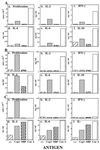Copolymer 1 induces T cells of the T helper type 2 that crossreact with myelin basic protein and suppress experimental autoimmune encephalomyelitis
- PMID: 9380718
- PMCID: PMC23498
- DOI: 10.1073/pnas.94.20.10821
Copolymer 1 induces T cells of the T helper type 2 that crossreact with myelin basic protein and suppress experimental autoimmune encephalomyelitis
Abstract
The synthetic amino acid copolymer copolymer 1 (Cop 1) suppresses experimental autoimmune encephalomyelitis (EAE) and is beneficial in multiple sclerosis. To further understand Cop 1 suppressive activity, we studied the cytokine secretion profile of various Cop 1-induced T cell lines and clones. Unlike T cell lines induced by myelin basic protein (MBP), which secreted either T cell helper type 1 (Th1) or both Th1 and Th2 cytokines, the T cell lines/clones induced by Cop 1 showed a progressively polarized development toward the Th2 pathway, until they completely lost the ability to secrete Th1 cytokines. Our findings indicate that the polarization of the Cop 1-induced lines did not result from the immunization vehicle or the in vitro growing conditions, but rather from the tendency of Cop 1 to preferentially induce a Th2 response. The response of all of the Cop 1 specific lines/clones, which were originated in the (SJL/JxBALB/c)F1 hybrids, was restricted to the BALB/c parental haplotype. Even though the Cop 1-induced T cells had not been exposed to the autoantigen MBP, they crossreacted with MBP by secretion of interleukin (IL)-4, IL-6, and IL-10. Administration of these T cells in vivo resulted in suppression of EAE induced by whole mouse spinal cord homogenate, in which several autoantigens may be involved. Secretion of anti-inflammatory cytokines by Cop 1-induced suppressor cells, in response to either Cop 1 or MBP, may explain the therapeutic effect of Cop 1 in EAE and in multiple sclerosis.
Figures




References
-
- Mosmann T R, Cherwinski H, Bond M W, Gieldin M A, Coffman R L. J Immunol. 1986;136:2348–2357. - PubMed
-
- Mosmann T R, Coffman R L. Annu Rev Immunol. 1989;7:145–173. - PubMed
-
- Abbas A K, Murphy K M, Sher A. Nature (London) 1996;383:787–793. - PubMed
-
- Liblau R S, Singer S M, McDevitt H O. Immunol Today. 1995;16:34–38. - PubMed
-
- Nicholson L B, Kuchroo V K. Curr Opin Immunol. 1996;8:837–842. - PubMed
Publication types
MeSH terms
Substances
LinkOut - more resources
Full Text Sources
Other Literature Sources

